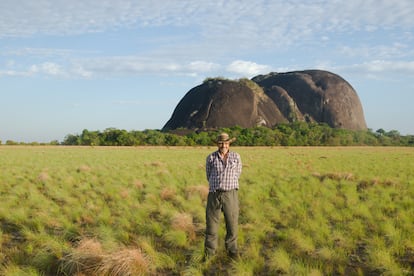A series of monumental engravings carved thousands of years ago to represent snakes, giant centipedes and human figures shed new clues about the human groups that inhabited what is now the border between Colombia and Venezuela thousands of years ago. The discovery, made in an area known as the Atures Rapids, in the Middle Orinoco, the region where the bed of the third largest river in the world separates both countries, includes at least 14 new sites with rock engravings, the size of Between 25 and 40 meters long makes them the largest recorded in the world.
Most of the designs engraved on the monumental rocks represent animals from the region, as well as human figures and geometric shapes. The largest, however, mostly include designs of some species of boa or anaconda, the mythical South American snakes that inhabit both the Orinoco basins and the Amazon. The reason is not fortuitous: the snakes of the region are part of the local indigenous worldview and play a key role in the myths and beliefs surrounding the Orinoquía.
“Snakes are generally interpreted as quite threatening, so the location of the rock art could be a sign that these are places that demand respect,” explains Phil Riris, lead author of the study published in the prestigious journal Antiquity. “We believe that the engravings could have been used by prehistoric groups as a way of marking territory, letting people know that this is where they live and that appropriate behavior is expected,” Riris says in a statement.

The region where the majority of the engravings are found, some discovered since 2015, was a key trade and transit route. Being a point in the Orinoco especially suitable for navigation, the hypothesis of the authors of the study suggests that the area served as a key meeting point, so that “leaving a mark there could have been even more important for that reason: to mark a local identity and let visitors know that you and your group are there,” says José Oliver, co-author of the study. The arrangement and size of the engravings, carved on the granite surface to create a clear contrast between the composition of the rocks, suggests to specialists that these were signs created to be seen from a distance.
Newsletter
The analysis of current events and the best stories from Colombia, every week in your mailbox
RECEIVE THE

Despite the difficulty in establishing an approximate date of its creation, the motifs carved into the stone coincide with ceramic remains from the region that date back about a thousand years, although it is not ruled out that they could be older. The discovery, made by a multidisciplinary team made up of the University of the Andes, Bournemouth University and University College London, increases the understanding of the environment in which human groups lived in South America thousands of years ago; and of a little explored facet of rock art, commonly associated with the representation of large mammals such as mammoths, deer and bison in Europe and Asia.
art.Dr. José Oliver
Subscribe here to the EL PAÍS newsletter about Colombia and here to the channel on WhatsAppand receive all the information keys on current events in the country.
#Colombian #British #scientists #find #largest #rock #carvings #world #Orinoco #basin
